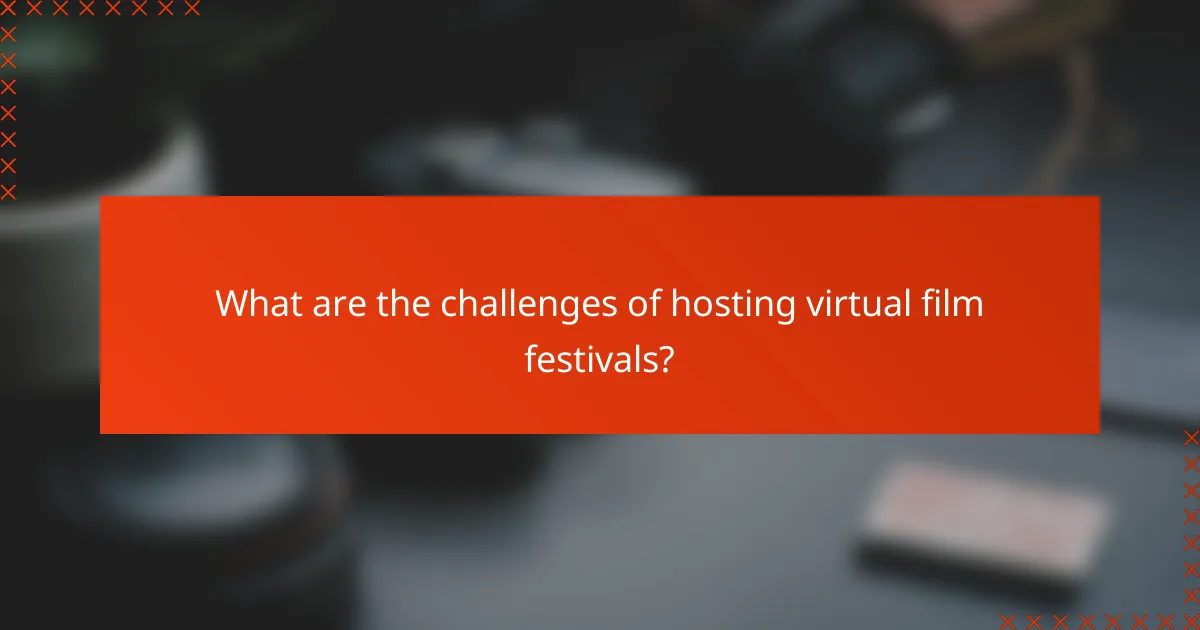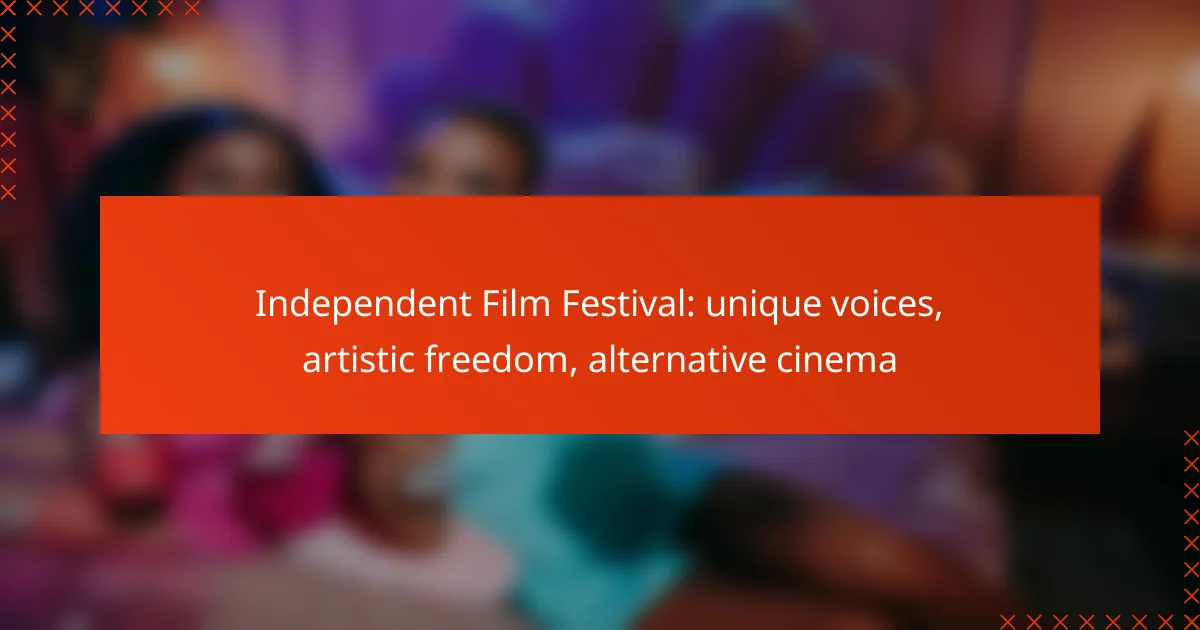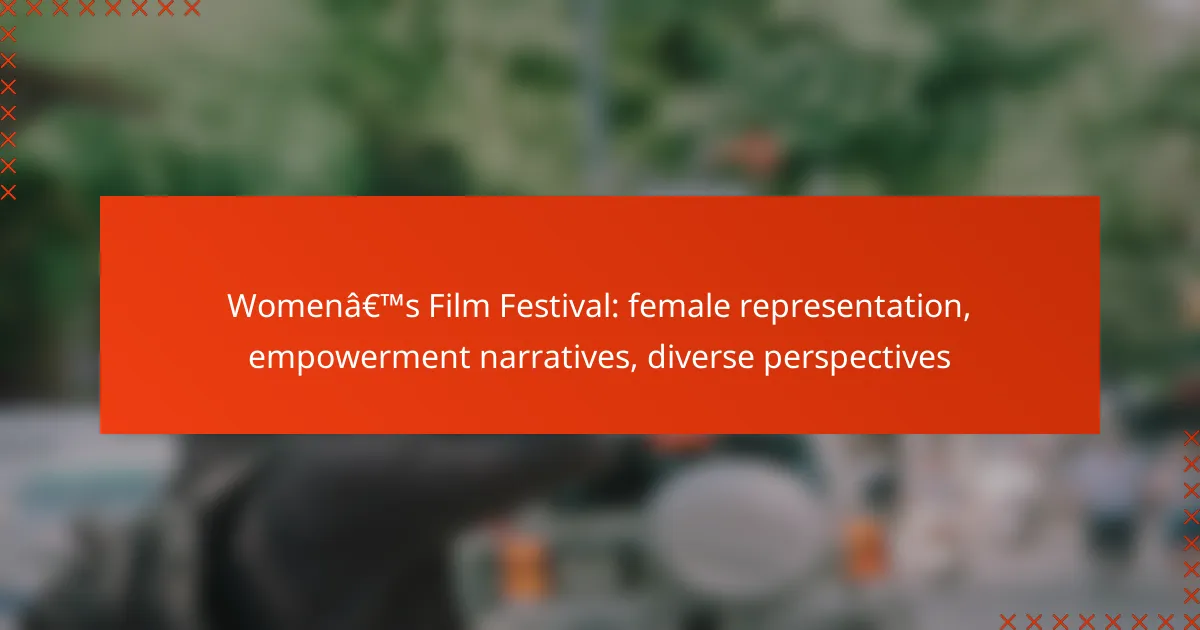Virtual film festivals are revolutionizing accessibility in Australia by incorporating features that accommodate diverse audiences, including those with disabilities or language barriers. By leveraging innovative formats such as interactive sessions and immersive technologies, these festivals enhance audience engagement and create flexible viewing options that cater to various preferences. This approach not only fosters a more inclusive environment but also encourages meaningful connections among viewers, ultimately boosting participation and retention.

How can virtual film festivals enhance accessibility in Australia?
Virtual film festivals can significantly improve accessibility in Australia by offering various features that cater to diverse audiences. These enhancements ensure that individuals with disabilities or language barriers can fully engage with the content and participate in the festival experience.
Live captioning services
Live captioning services provide real-time text representation of spoken dialogue during film screenings and discussions. This feature is essential for individuals who are deaf or hard of hearing, allowing them to follow along without missing critical information. Many platforms now offer integrated captioning options, making it easier for festival organizers to implement this service.
When selecting a live captioning provider, consider factors such as accuracy, speed, and the ability to handle multiple speakers. Ensuring that captions are synchronized with audio is crucial for a seamless viewing experience.
Audio description options
Audio description enhances accessibility for visually impaired audiences by providing narrated descriptions of key visual elements during a film. This service allows viewers to understand the context and actions occurring on screen, making the experience more inclusive. Festivals can offer audio descriptions as an optional feature for select films.
To implement audio descriptions effectively, filmmakers should work with trained professionals who can create clear and concise narratives that complement the dialogue without overshadowing it. Providing this option can significantly broaden the audience base.
Subtitles in multiple languages
Offering subtitles in multiple languages can make films accessible to non-English speakers and those learning the language. This feature not only caters to Australia’s multicultural population but also enhances the festival’s reach. Subtitles should be accurately translated and synchronized with the film’s audio for optimal understanding.
When planning for multilingual subtitles, consider the primary languages spoken in the target audience. Collaborating with professional translators can help ensure that the nuances of the original dialogue are preserved, making the content more relatable.
Virtual networking opportunities
Virtual networking opportunities allow attendees to connect with filmmakers, industry professionals, and fellow viewers through online platforms. This interaction can take place via chat rooms, video calls, or dedicated forums, fostering a sense of community despite physical distances. Such opportunities are vital for building relationships and sharing insights.
To maximize engagement, festivals should schedule dedicated networking sessions and provide clear guidelines on how participants can interact. Encouraging discussions around specific films or themes can enhance the experience and lead to meaningful connections.
Flexible viewing times
Flexible viewing times enable audiences to watch films at their convenience, accommodating different schedules and time zones. This feature is particularly beneficial for those with disabilities or caregiving responsibilities, as it allows them to participate without the pressure of fixed screening times. Festivals can offer on-demand access to films for a limited period.
When implementing flexible viewing, consider setting clear time frames for access and ensuring that promotional materials communicate these options effectively. This approach can significantly increase attendance and viewer satisfaction.

What innovative formats are used in virtual film festivals?
Virtual film festivals leverage innovative formats to enhance audience engagement and accessibility. These formats include interactive sessions, immersive technologies, and flexible viewing options that cater to diverse viewer preferences.
Interactive Q&A sessions
Interactive Q&A sessions allow audiences to engage directly with filmmakers and actors after screenings. This format fosters a sense of community and provides deeper insights into the creative process. Organizers can use platforms like Zoom or YouTube Live to facilitate these discussions, often allowing viewers to submit questions in real-time.
To maximize participation, consider scheduling these sessions at different times to accommodate various time zones. Promoting these events through social media can also boost attendance and engagement.
Virtual reality screenings
Virtual reality (VR) screenings offer an immersive experience that traditional formats cannot match. Viewers can don VR headsets to enter a 360-degree environment, making them feel as if they are part of the film. This format is particularly effective for documentaries and experimental films that benefit from a more engaging presentation.
When implementing VR screenings, ensure that you provide clear instructions for users on how to access and navigate the VR experience. Offering a selection of films in this format can attract tech-savvy audiences and enhance the festival’s appeal.
Hybrid event models
Hybrid event models combine in-person and virtual elements, allowing audiences to choose their preferred viewing method. This approach can increase accessibility, as it accommodates those who may not be able to attend physically due to distance or health concerns. Hybrid models can also expand the festival’s reach beyond local audiences.
To execute a successful hybrid event, invest in quality streaming technology to ensure a seamless experience for both in-person and online attendees. Consider ticket pricing strategies that reflect the different experiences, such as lower prices for virtual access.
On-demand content access
On-demand content access enables viewers to watch films at their convenience, extending the festival’s reach and engagement. This format allows audiences to explore a wider range of films without the constraints of a fixed schedule. It also caters to varying viewer preferences, accommodating those who may have busy schedules.
When offering on-demand access, set a clear timeframe for availability, such as a week or two after the festival’s conclusion. Providing curated playlists or themed collections can help guide viewers toward films they might enjoy, enhancing their overall experience.

How do online engagement strategies impact audience participation?
Online engagement strategies significantly enhance audience participation by creating interactive and immersive experiences. These strategies encourage viewers to connect with the content and each other, leading to increased attendance and retention during virtual film festivals.
Social media integration
Integrating social media into virtual film festivals allows audiences to share their experiences in real-time, fostering a sense of community. Platforms like Twitter and Instagram can be used for live updates, behind-the-scenes content, and audience reactions, which can amplify engagement.
Consider creating dedicated hashtags for discussions and promotions. This not only encourages participation but also helps in tracking audience sentiment and feedback throughout the event.
Gamification elements
Incorporating gamification elements, such as challenges or rewards, can motivate audiences to engage more deeply with the festival. For example, offering points for attending screenings, participating in discussions, or sharing content can enhance the overall experience.
Simple rewards, like exclusive content access or merchandise discounts, can incentivize participation. Ensure that these elements are easy to understand and accessible to all participants to maximize engagement.
Audience voting systems
Implementing audience voting systems allows viewers to express their preferences and influence outcomes, such as selecting award winners or favorite films. This interactive approach not only increases engagement but also gives participants a sense of ownership in the festival.
Consider using online platforms that facilitate real-time voting, ensuring the process is straightforward and secure. Clear instructions and reminders can help boost participation in voting activities.
Live chat features
Live chat features enable real-time interaction between audiences, filmmakers, and hosts, enhancing the communal aspect of virtual film festivals. These chats can facilitate discussions, Q&A sessions, and networking opportunities, making the experience more dynamic.
To maximize effectiveness, appoint moderators to guide conversations and keep discussions on track. Encouraging questions and comments during screenings can lead to a richer dialogue and greater audience involvement.

What are the best practices for promoting virtual film festivals?
Effective promotion of virtual film festivals relies on a combination of targeted strategies that engage audiences and maximize visibility. Utilizing digital advertising, influencer partnerships, and email marketing can significantly enhance attendance and participation.
Targeted digital advertising
Targeted digital advertising allows film festivals to reach specific demographics based on interests, location, and online behavior. Platforms like Facebook and Google Ads enable precise targeting, ensuring that promotional content reaches potential attendees who are most likely to engage.
Consider allocating a budget that allows for A/B testing of different ad formats and messages. This approach helps identify which ads resonate best with your audience, optimizing your spending for maximum impact.
Influencer partnerships
Collaborating with influencers can amplify the reach of your virtual film festival. Influencers with a strong following in film, culture, or entertainment can create buzz and drive ticket sales through authentic endorsements.
When selecting influencers, focus on those whose audience aligns with your festival’s theme. A micro-influencer with an engaged community may be more effective than a celebrity with a broader but less targeted reach.
Email marketing campaigns
Email marketing remains a powerful tool for promoting virtual film festivals. Crafting engaging newsletters that highlight festival features, schedules, and exclusive content can keep your audience informed and excited.
Segment your email list to tailor messages to different audience groups, such as past attendees or new subscribers. Personalization can significantly increase open rates and engagement, leading to higher ticket sales.

What are the challenges of hosting virtual film festivals?
Hosting virtual film festivals presents several challenges, including technical reliability, maintaining audience engagement, and competing with traditional in-person events. Addressing these issues is crucial for ensuring a successful online experience for both filmmakers and viewers.
Technical issues and platform reliability
Technical issues can significantly impact the success of a virtual film festival. Common problems include streaming interruptions, platform crashes, and poor video quality, which can frustrate viewers and deter participation. Selecting a reliable streaming platform with a proven track record can help mitigate these risks.
It’s essential to conduct thorough testing before the event. This includes checking internet bandwidth, ensuring compatibility with various devices, and having backup systems in place. Consider using platforms that offer customer support during the event to quickly address any issues that arise.
Audience engagement retention
Keeping the audience engaged during a virtual film festival can be challenging, as distractions are more prevalent at home. To enhance engagement, organizers can incorporate live Q&A sessions, interactive polls, and social media integration to create a sense of community among viewers.
Offering incentives, such as exclusive content or virtual meet-and-greets with filmmakers, can also help retain audience interest. Regular communication through email reminders and social media updates can keep the festival top-of-mind for attendees.
Competition with in-person events
Virtual film festivals face stiff competition from traditional in-person events, which often provide a more immersive experience. To stand out, virtual festivals should emphasize unique features, such as accessibility to a global audience and the ability to watch films at one’s convenience.
Highlighting the benefits of virtual attendance, such as lower ticket prices and the option to view films from the comfort of home, can help attract participants. Additionally, creating a strong marketing strategy that showcases the festival’s unique offerings can help draw in audiences who might otherwise prefer in-person events.



